

Mimicry
PHOTO
(UPPER) The nudibranch Phyllidiella pustulosa (left) and the turbellarian flatworm Pseudoceros imitatus (right).
Photo: L.Newman & A.Flowers. Heron Island
(MIDDLE) Chromodoris geometrica, Coffs Harbour Region, northern New South Wales, December 1990. Photo: Bill Rudman.
(LOWER:) Chromodoris geometrica and flatworm mimic from Philippines. Photo: Michael Miller.
RELATED TOPIC
There are many examples of animals which have evolved to look almost identical to another animal. There are spiders which look like ants, flies that look like wasps, harmless butterflies which look like poisonous butterflies, and many more. We call this mimicry, and usually one animal is considered to be the model and the other to me the mimic. In most cases which have been studied the mimic gains an advantage. For example, if a tasty animal looks like a poisonous one it is less likely to be eaten, and at the other extreme, if a dangerous animal looks like a harmless one, it can creep up on its prey without raising an alarm.
The example I illustrate here are the phyllidiid dorid nudibranchs such as Phyllidiella pustulosa. The phyllidiids exude very noxious and toxic chemicals from their skin and appear to be avoided by most fish. They are often the only sea slugs which blatantly crawl out in the open during the day. Other nudibranchs, flatworms, and even a holothurian are known to mimic phyllidiid nudibranchs.
See also:
Colour in sea slugs, red-spotted chromodorids in southeasterb Australia, Aposematism, three pages where aposematism and colour pattern mimicry are described.
• Discodoris? liturata, an almost perfect mimic of Phyllidiella pustulosa.
• Aldisa erwinkoehleri, an equally amazing mimic of Phyllidia.
• Doris? sp. 3, an equally amazing mimic of Phyllidiopsis.
• Aldisa williamsi, another phyllidiid mimic from Indonesia.
Rudman, W.B., 2004 (July 23) Mimicry. [In] Sea Slug Forum. Australian Museum, Sydney. Available from http://www.seaslugforum.net/find/mimicry
Related messages
Holothurian phyllidiid mimic
May 18, 2005
From: Valérie Besnard
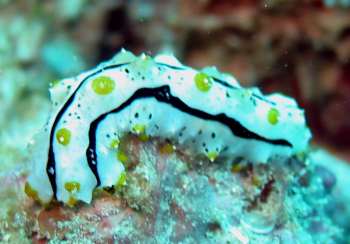
valeriebesnard@aol.com
Besnard, V., 2005 (May 18) Holothurian phyllidiid mimic. [Message in] Sea Slug Forum. Australian Museum, Sydney. Available from http://www.seaslugforum.net/find/13782Dear Valérie,
Yes this does look like a phyllidiid but actually it is a juvenile sea cucumber. It's name is Bohadschia graeffei [or perhaps Pearsonothuria graeffei], and when juvenile it has this colourful phase, but as it grows it becomes a typical boring brownish sea cucmber. Have a look at the messages attached to the Mimicry Fact Sheet for more discussion on the animal.
Best wishes,
Bill Rudman
Flatworm mimic of Chromodoris magnifica
January 19, 2004
From: Mary Jane Adams
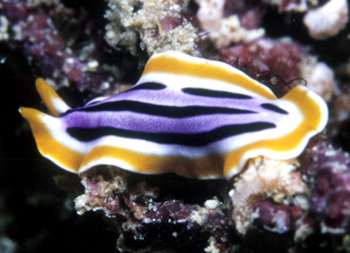
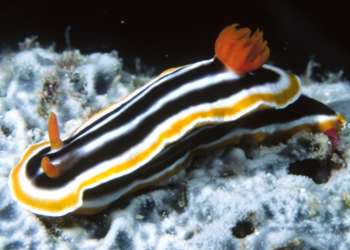
Hi Bill,
When I first saw this Pseudoceros sp. flatworm in a dark hole in the reef on Mabul Island, Sabah, Malaysia I thought it was a nudibranch. However, its rapid gliding movement tipped me off that it
a flatworm in disguise.
It was about 10 mm long and about 10 meters deep on "Old Lobster Cave Wall" Nov. 29, 2003. I think the nudibranch it resembles most is Chromodoris magnifica like this one from Milne
Bay, PNG.
Best regards,
Mary Jane
divepng@yahoo.com
Adams, M.J., 2004 (Jan 19) Flatworm mimic of Chromodoris magnifica. [Message in] Sea Slug Forum. Australian Museum, Sydney. Available from http://www.seaslugforum.net/find/11905Thanks Mary Jane,
This flatworm, which I think is Pseudoceros scriptus Newman & Cannon, 1998 is found throughout the Indo-West Pacific and is most probably a mimic of many of the Chromodoris quadricolor colour group. In some cases the blue has darker specks all over, and the black lines are broken, making it look very like Chromodoris michaeli. Mimicry is a fascinating area for conjecture - and I have done a bit in my time - but unfortunately it is very difficult to show scientifically that there is any significance to two animals looking almost identical. Despite that, I would like to think that this flatworm and the chromodorids are not just similarly coloured by chance.
Best wishes
Bill Rudman
Bohadschia / Pearsonothuria
January 8, 2004
From: Bob Bolland
Hi Bill,
In an earlier message on the Forum you asked about a reference to the holothuroidean Genus Pearsonothuria. I asked Gordon Hendler (L.A. Co. Mus. Nat. Hist. / Echinoderms) about this and he supplied the following references:
• Samyn, Yves. 2003. Towards an understanding of the shallow-water holothuroid fauna (Echinodermata: Holothuroidea) of the Western Indian Ocean. Ph. D. Dissertation, Vrije Universiteit Brussel. 384 pp. + Annex CD ROM.
He uses Pearsonothuria without any comment. However in the accompanying CD there is a paper by:
• Kerr, A.M., D.A. Janies, R.M. Clouse, Y. Samyn, W.C. Wheeler and J. Kirn. Molecular phylogeny of coral-reef sea cucumbers (Holothuriidae: Aspidochirotida) based on 16S mt rDNA sequence. (Submitted to Molecular Phylognetics and Evolution). It shows Pearsonothuria and Bohadschia as sister taxa.
Cheers,
Bob Bolland
bollandr@rapid-link.ne.jp
Bolland, R.F., 2004 (Jan 8) Bohadschia / Pearsonothuria. [Message in] Sea Slug Forum. Australian Museum, Sydney. Available from http://www.seaslugforum.net/find/11818Thanks Bob,
Bill Rudman
Bohadschia graffei as mimic of Phyllidia varicosa
October 17, 2003
From: Rosalind Day
Dear Bill
Having now completed my investigation into the ecology and feeding behaviour of this species, I thought I should share some information about its identification. It turns out that the species Bohadschia graffei was reclassified in 1984 to Pearsonothuria graffei due to differences from other Bohadschia species in terms of spicule morphology.
I still hope to continue my studies and have uncovered much information about its ecology, feeding behaviour and possible sensory activity if any of your readers were to make further enquiries.
I understand that this is only an off shoot from the real interest in sea slugs, but hope it may be of interest.
Sincerely
Ros Day
chocchipstarfish@yahoo.co.uk
Day, R., 2003 (Oct 17) Bohadschia graffei as mimic of Phyllidia varicosa. [Message in] Sea Slug Forum. Australian Museum, Sydney. Available from http://www.seaslugforum.net/find/11248Dear Rosalind,
Thanks for keeping in touch. Name changes like this are good to know as often only the experts in a field know about while the rest of us continue to use out-dated names. I presume the same often happens when non-experts write about nudibranchs. A reference to the name change would be nice to include
Thanks
Bill Rudman
Re: Phyllidia varicosa mimic
March 24, 2003
From: Marina Poddubetskaia
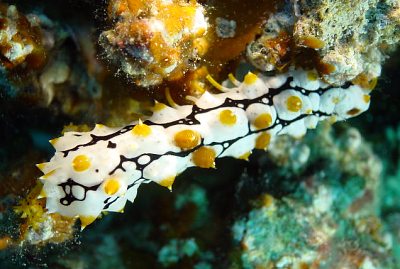
Dear Ros,
Concerning your query about Bohadschia graffei juveniles as a mimic of Phyllidia varicosa. Recently, I had a diving cruise to Brothers Islands, in the Red Sea. Near Safaga I found this juvenile Bohadschia graeffei. It was just on a hard coral.
It seems that it mimics Phyllidia varicosa but there were very few nudibranchs there and I didn’t see any blue phyllidiid with yellow tubercles. I hope this record will help you in your research.
Date: February 09, 2003
Location: Safaga, Egypt, Red Sea
Site: Panorama Reef
Depth: 10m
Size: 65-70mm
Photos: Marina Poddubetskaia - Nembro website
Best wishes,
Marina.
nembro@nembro.info

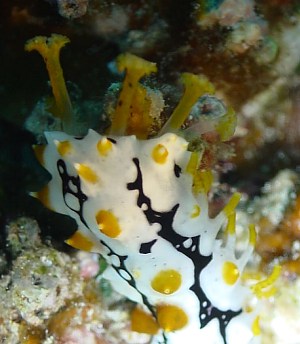
Dear Marina,
Thanks for these wonderful photos of the holothurian Bohadschia graeffei. To those with little knowledge of holothurians or sea cucumbers, the lower left photo shows the tube feet (yellow) very well. These are the same organs which enable it, and its close relatives, the starfish and sea urchins, to 'walk'. The lower right photo shows the circlet of oral feeding tentacles around the mouth which enables it to collect the detritus and organic matter it eats, from the substrate.
Now I have finished the anatomy lesson here is a comment on mimicry and your bservation that there were no 'models' - that is blue and yellow phyllidiids around. Mimicry is quite difficult to prove, and I am sure some similar colour patterns have evolved by chance, or the predators who are supposedly fooled by the trickery can't see the colours. But with that caution, there are certainly many examples of remarkable mimicry. I don't know whether the juvenile holothurian is mimicking phylidiids, but if it is then the mimicry would have evolved over a long time period. It is certainly n necessary for model and mimic to be around together at all times,
Best wishes,
Bill Rudman
Phyllidia varicosa mimic
November 15, 2002
From: Rosalind Day
I am currently researching the Holothuroidean Bohadschia graffei and am trying to gather information on the juveniles which mimic Phyllidia varicosa. I did not find any juveniles in Wakatobi Marine National Park, south east Sulawesi, Indonesia where my research was carried out. If any one has any information on sightings of juveniles from anywhere I would love to hear from you.
Many Thanks
Ros Day
Essex University
rcday@essex.ac.uk
Day, R., 2002 (Nov 15) Phyllidia varicosa mimic. [Message in] Sea Slug Forum. Australian Museum, Sydney. Available from http://www.seaslugforum.net/find/8412Dear Ros,
Wolfgang Seifarth's photo shows just how remarkable this mimicry is.
Best wishes,
Bill Rudman
Phyllidia mimicry
May 18, 2002
From: Erwin Köhler
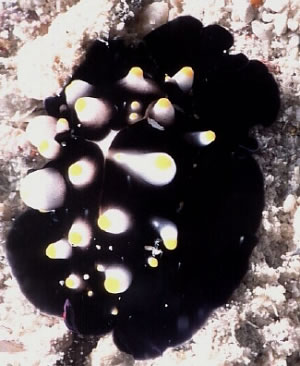
Dear Bill,
Here is a shot of Britta Hochberger (email Britta.Hochberger@t-online.de from Indonesia, Nabucco Island, divesite "Sand Rich". It shows a juvenile egg-cowrie Ovula ovulum which appears to mimic Phyllidia madangensis.
Size 1-2 cm, Depth 14m, 17 March 2002
Cheers,
Erwin
Erwin@medslugs.de
Köhler, E., 2002 (May 18) Phyllidia mimicry. [Message in] Sea Slug Forum. Australian Museum, Sydney. Available from http://www.seaslugforum.net/find/6952Thanks Erwin,
It certainly has similarities to P. madangensis but 'mimicry' has a special biological meaning and it is very difficult to demonstrate that 2 animals that look alike are the result of some long term evolutionary selection process. Even the idea that the juvenile holothurian in Wolfgang's wonderful photo is mimicking a species of Phyllidia is based on intuition rather than evidence.
Cheers,
Bill Rudman
Why do some nudibranchs share the same colour patterns?
March 13, 2002
From: joe
Where can I find information about why some nudibranchs share the same colour patterns?
Joe.
jczero1@hotmail.com
joe, 2002 (Mar 13) Why do some nudibranchs share the same colour patterns?. [Message in] Sea Slug Forum. Australian Museum, Sydney. Available from http://www.seaslugforum.net/find/6406Dear Joe,
Have a look at the following two pages - Defensive colouration and Mimicry. If you read the messages at the bottom of each page, and my comments, you will should find the information you require. By chance I have just posted a couple of messages today about a couple of amazing examples of the mimicry you are asking about. See the pages on Aldisa williamsi and Aldisa erwinkoehleri. I don't know where in the world you are from, so I can't suggest a particularly relevant example, but the red-spotted chromodorids of southeastern Australia are quite a spectacular example.
Best wishes,
Bill Rudman
Nudibranch & Flatworm mimicry
March 5, 2002
From: Adam Brown
I have an essay titled 'Why do some Marine flatworms and sea-slugs share the same bright colour patterns?' and I was wondering if you had some information.
Brilliant if you have and thanks.
adam.brown2@orange.net
Dear Adam,
Have a look at the following two pages - Defensive colouration and Mimicry. If you read the messages and my comments you will should find the information you require. For the flatworm's point of view have a look at Wolfgang Seifarth's Marine Flatworms of the World at http://www.rzuser.uni-heidelberg.de/~bu6/index.html.
Best wishes,
Bill Rudman
Is this fish a Sea Slug Mimic?
May 2, 2000
From: Mark McGrouther

Hi Bill,
I am about to put up a page on the museum's fish website on the harlequin sweetlips. As a juvenile, this fish is brown with large white spots. It swims with an undulating motion. It is believed to be a nudi or flatworm mimic. Do you know what it could be mimicking? I would ideally like to link to one of your pages. I had a quick squiz but couldn't find anything resembling the fish in the Sea Slug Forum.
[Harlequin Sweetlips - juvenile Plectorhinchus chaetodonoides Lacepède, 1800. PHOTO: Grey McNeil]
Thanks,
Mark McGrouther
Collection Manager (Fishes)
Australian Museum
markm@austmus.gov.au
McGrouther , M., 2000 (May 2) Is this fish a Sea Slug Mimic?. [Message in] Sea Slug Forum. Australian Museum, Sydney. Available from http://www.seaslugforum.net/find/2348Dear Mark,
I can't think of any nudibranch it resembles. If anyone has an idea about which nudibranch, if any, this fish resembles can they let me know please?
Best wishes,
Bill Rudman.
Holothurian Phyllidia mimic
December 21, 1999
From: Wolfgang Seifarth
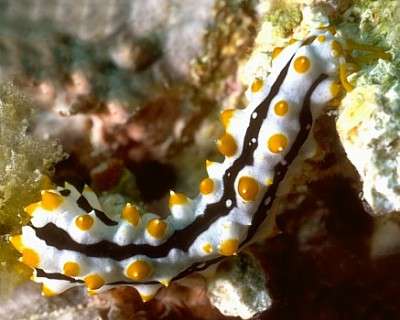
Dear Bill;
I am sending you a pic (attached) from a recent dive trip to Ellaidhoo, Ari Atoll, Maldives, where I found this small sea cucumber which obviously mimicks the phyllidiid sea slug Phyllidia varicosa. The specimen observed
had a size of about 2 cm (in a depth of about 8 m on coral rubble) indicating that it is probably a juvenile form of a holothuroid echinoderm (see mouth tentacles at the right end).
I think it is very interesting that not only flatworms but also holothuroids are mimicking sea slugs!
Merry christmas and a happy new year!
Wolfgang
Wolfgang.Seifarth@urz.uni-heidelberg.de
Seifarth, W., 1999 (Dec 21) Holothurian Phyllidia mimic. [Message in] Sea Slug Forum. Australian Museum, Sydney. Available from http://www.seaslugforum.net/find/1695Dear Wolfgang,
Thanks for the best wishes and thanks for the wonderful photo.
You are right in surmising that this is a juvenile holothurian. Even more interesting is that this species, Bohadschia graeffei, changes colour from juvenile to adult. It starts life as a brightly coloured mimic of very distasteful phyllidiid nudibranchs, such as Phyllidia varicosa and P. coelestis, but when it grows larger than phyllidiids grow, it gradually changes to a camouflaged mottled white and brown colour more typical of other species of the genus Bohadschia.
There are some photos of the intermediate and adult stages in Gosliner, Behrens & Williams (1996) Coral reef Animals of the Indo-Pacific.
Bill Rudman.
Rudman, W.B., 1999 (Dec 21). Comment on Holothurian Phyllidia mimic by Wolfgang Seifarth. [Message in] Sea Slug Forum. Australian Museum, Sydney. Available from http://www.seaslugforum.net/find/1695About Mimicry & flatworms
July 11, 1999
From: Christine
Dear Dr. Rudman,
I recently gave a little talk about nudibranchs to the scuba divers on board the boat 'Pro Diver' in Brisbane. I gave the example that the flatworm Pseudoceros imitatus mimics Phyllidia pustulosa. One of the divers wanted to know how the flatworm 'knew' what the nudibranch looked like, so that it could copy it, since flatworms only have primitive eyes?
My guess is that flatworms 'tried' a number of colours and patterns by chance, and that the Pseudoceros pattern was selected through increased survival because of its likeness to Phyllidia.
Is there a better explanation?
Also, are flatworm tentacles analogous to nudibranch rhinopores?
Thanks!
Christine.
cmc_tigger@hotmail.com
Christine, 1999 (Jul 11) About Mimicry & flatworms. [Message in] Sea Slug Forum. Australian Museum, Sydney. Available from http://www.seaslugforum.net/find/1020Dear Christine,
Mimicry is a good example of evolution at work. It is difficult not to give human attributes to animals when explaining how evolution works but it is important not to give the impression that the process is 'guided towards perfection'. Evolution is directionless. To say they 'tried' a number of patterns suggests they were aiming at a goal which is quite the wrong way to approach it.
If we go back to first principles - as first stated by Charles Darwin - to be 'fit' or 'survivable' species must occur in large numbers and show variability. If, or rather when, environmental conditions change, there is a good likelihood that some members of a very variable species will be able survive in the new conditions and so pass on their selection of the original genes to the next generation.
In the case of Phyllidia and the flatworm, let us presume that Phyllidia is the 'model'. Phyllidia has extremely toxic and distasteful secretions which deter fish from eating it. Fish learn to avoid the Phyllidia-shape and colour and so Phyllidia are somewhat protected from predation. In this case, any animal that looks like Phyllidia will gain some protection from predation by 'tricking' predatory fish into thinking they are a Phyllidia. If a flatworm species has a vaguely similar shape and colour to Phyllidia then those individuals that look most like a Phyllidia are most likely to escape fish attack. Gradually the surviving flatworms of each generation will become more and more like Phyllidia simply because only those with the genes to look like Phyllidia will survive. At no time will the flatworms 'know' they are improving their chances of survival, or even that there are lots of Phyllidia in their environment.
In more complicated situations there can be two or three mimic species and sometimes some or all will be distasteful. In other cases there can be many species, all of which are distasteful, as I describe for the red-spotted chromodorids of southeastern Australia.
Concerning flatworm 'tentacles'. Yes they are sensory and as with the nudibranch rhinophore can detect chemical 'smells' in the water.
Best wishes,
Bill Rudman.
Mimicry topic continued
April 15, 1999
From: Michael D. Miller
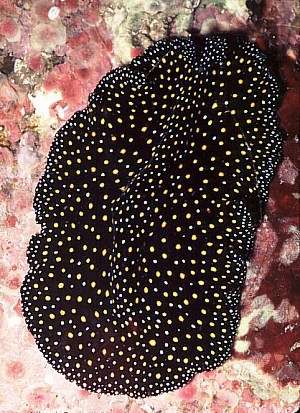
Dear Bill,
Here is a pic of a Flatworm (Pseudoceros bajae)that should have been included with the pics of Navanax inermis and Hypselodoris ghiselini previously posted. As it turns out, this same uncanny correlation between the three subjects was earlier noted in a publication by Terry Gosliner and
Dave Behrens entitled "Adaptive Coloration in Invertebrates" presented at College Station, Texas in 1989.
All three were encountered on one dive at Punta La Gringa, Bahia de Los Angeles, Baja California during the February field trip.
Truly amazing!
Cheers;
Mike Miller
mdmiller@cts.com
Miller, M.D., 1999 (Apr 15) Mimicry topic continued. [Message in] Sea Slug Forum. Australian Museum, Sydney. Available from http://www.seaslugforum.net/find/776Thanks Mike.
Mimicry revisited
April 7, 1999
From: Mike Miller
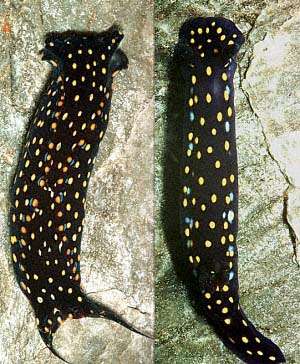
Dear Bill,
Sometimes in this business of branching, it is not always easy to distinguish the hunter from the hunted at first glance. As for example, in the pic attached you will find the right frame occupied by Hypselodoris ghiselini, a sea slug noted for its secretion of obnoxious chemicals for defence purposes. In the left frame will be found Navanax inermis, a voracious predator of other branchs that tracks the potential victim's slime trail.
Both pictures recorded at Bahia de Los Angeles, Baja California during a recent field trip.
Cheers;
Mike Miller
Miller, M.D., 1999 (Apr 7) Mimicry revisited. [Message in] Sea Slug Forum. Australian Museum, Sydney. Available from http://www.seaslugforum.net/find/759Dear Mike,
Thanks for the pics. By chance while I was looking through Dave Behrens Pacific Coast Nudibranchs to check on the spelling of 'ghiselini' I came across his picture of Polycera alabe which seems to be remarkably similar in colour to the other two species. It also seems to have a similar distribution.
It seems that Navanax inermis is quite variable in colour. In the other photo I have posted it has a striped pattern.
Do you know if Navanax and H. ghiselini have similar distributions? if your suggestion is that Navanax is mimicking the nasty tasting H. ghiselini it would be nice if their distributions overlapped and N. inermis only had the spotted pattern where it coincided with H. ghiselini - but I guess that would just be wishful thinking on my part.
Thanks again,
Bill Rudman.
Mimicry: Flatworm & C. geometrica
January 15, 1999
From: Michael Miller
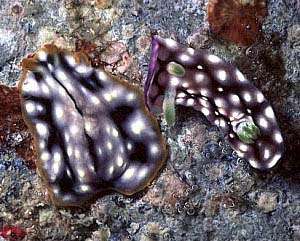
Dear Bill
Picking up once again on the theme of mimicry, you will find an attached photo of Chromodoris geometrica and an undescribed flatworm that was photographed by Terry Gosliner on one of our Philippine field trips.
Cheers;
Mike
mdmiller@cts.com
Miller, M.D., 1999 (Jan 15) Mimicry: Flatworm & C. geometrica. [Message in] Sea Slug Forum. Australian Museum, Sydney. Available from http://www.seaslugforum.net/find/472Thanks Mike,
By coincidence Erwin Koehler has just sent me photos of this distinctive colour form of Chromodoris geometrica.
Bill Rudman.
More Phyllidiella mimic pics
December 3, 1998
From: Michael Miller
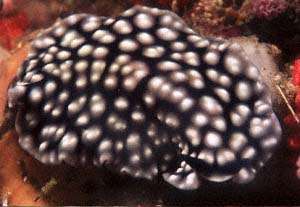
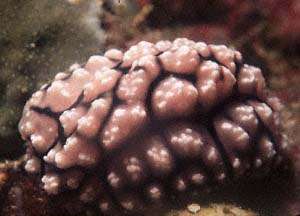
Dear Bill,
While diving in the Philippines earlier this year, I came across a specimen of Phyllidiella pustulosa on a wall but didn't think too much about it until the flatworm Pseudoceros imitatus was sighted a short distance from P. pustulosa. The resemblance of the flatworm to the the branch was uncanny.
Happenstance that they were both in close proximity??
Cheers;
Mike Miller
mdmiller@cts.com
Miller, M.D., 1998 (Dec 3) More Phyllidiella mimic pics. [Message in] Sea Slug Forum. Australian Museum, Sydney. Available from http://www.seaslugforum.net/find/354Thanks Mike,
They are amazing. I've rearranged the photo you sent me. If I'm right, the top photo is of the flatworm, the bottom of the phyllidiid? Let me know if they've fooled me.
Best wishes,
Bill Rudman
A case of mimicry
June 25, 1998
From: Wayne Ellis

Hi Bill,
Here is another of Steve Grail's photos. It was taken off Mooloolaba, Sunshine Coast, southern Queensland, in 10-20m, between 1996 and 1998.
Regards
Wayne Ellis
glaskin@ozemail.com.au
Ellis, W., 1998 (Jun 25) A case of mimicry. [Message in] Sea Slug Forum. Australian Museum, Sydney. Available from http://www.seaslugforum.net/find/82Wayne, The two nudibranchs in Steve's photo are quite unrelated. On the left is Chromodoris geometrica and on the right Phyllidiella pustulosa. During his study on phyllidiids, David Brunckhorst discovered a number of invertebrates which were very similar in shape and colour to phyllidiids. In 1994, Leslie Newman and Lester Cannon (Queensland Museum) described one of these - a remarkable flatworm, Pseudoceros imatatus. The chromodorid Chromodoris geometrica also has a close resemblance to Phyllidiella pustulosa. Phyllidiella pustulosa and its "look-alikes" are probably an example of what we call "mimicry". In most general terms "mimicry" is a process where one or more species evolves to resemble another species (the model) for some biological "gain".
There are many cases amongst butterflies where the colour pattern of a highly distasteful, often poisonous, butterfly is copied by other, quite edible butterflies. Because they have identical or very similar colour patterns, the edible butterflies gain considerable protection from feeding birds who have learnt from experience to leave the distasteful species alone.
In other more complicated examples, groups of unrelated species, sometimes all distasteful, have evolved a similar colour pattern for mutual protection.
In the case of Phyllidiella pustulosa, Chromodoris geometrica and Pseudoceros imatatus we have no direct evidence that these three are mimics and that they are part of a mutual protection system. However there is considerable circumstantial evidence to suggest they are. All phyllidiids contain extremely noxious chemicals which they can exude as a milky white secretion. Phyllidiella pustulosa is also one of the few tropical reef nudibranchs which displays itself obviously during the day, apparently immune to fish attack.
Both flatworms and chromodorids produce distasteful chemicals, but it seems most probable that Chromodoris geometrica and Pseudoceros imatatus are relying on their similarity to Phyllidiella pustulosa for protection.
Phyllidiella is much more common than the other two species, and both the Chromodoris and the Pseudoceros are unique amongst their closest relatives in having pustulose bodies, suggesting that pustules have evolved in these two species for a special purpose. If this suggestion is correct then Phyllidiella pustulosa is in this case the "model" and the other two are "mimics".
A much more complicated example can be found amongst the red-spotted chromodorids of southeastern Australia which are mentioned under Chromodoris splendida.
Bill Rudman
